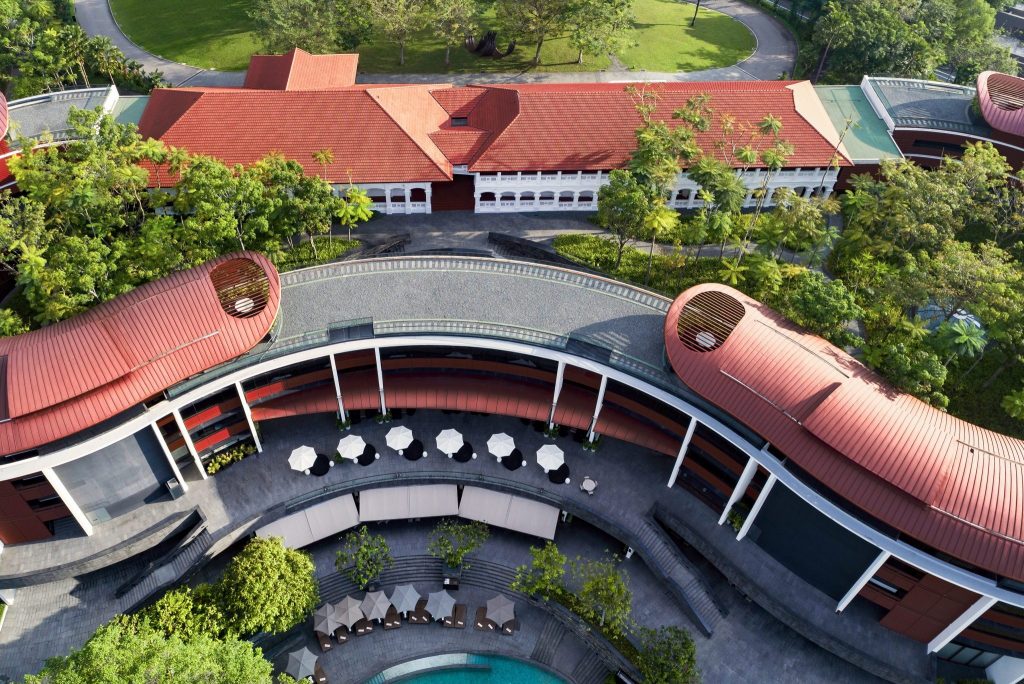Finding the Right Formula for Promoting Luxury Pandemic Staycations in Asia

Photo Credit: Capella Singapore: Who says locals won't holiday at home? Capella Singapore
Skift Take
Asia’s luxury hotels are competing for staycations with ideas, not price. A valuable outcome will be a rise in partnerships as hotels tie up with various local companies to curate new experiences to entice locals.
The priciest hotels in Singapore, Bangkok, and Hong Kong are clutching the prestigious status to their chests as the business of attracting local staycationers begins in earnest.
Local couples or families who hope that Covid-19 may offer them a chance to holiday in a six star at the price of a five star — especially as these cities have limited domestic demand — will be disappointed that rates, although discounted, still look fairly six stars-like when viewed against a pandemic light.
An entry-level staycation at Capella Singapore starts from $613 (S$846), while in Bangkok a staycation in a river view pool villa at The Siam costs $568 (17,900 baht). Both rates are per room per night and exclude taxes of 17 and 17.7 percent respectively.
A “We Meet Again - The Eight Loves of The Peninsula Hong Kong” costs $784 (HK$6,080) for a night's stay in a superior suite, although the second night or a second room is at half price. A chance to stay in a residence suite at Raffles in Singapore sets one back from $1,597 (S$2,199) excluding taxes, with the second night at 50 percent off.
An apparent price war is being waged only by run-of-the-mill five stars. In Bangkok, it's easy to find staycation rates for local residents of around $222 to $255 (7,000-8,000 baht) at branded five stars. Grandes dames and hotels that have successfully built prestige, on the other hand, are discounting judiciously and are more strategic in their intentions than just getting in as many warm bodies on beds. While their prices may appear high in a pandemic, the deals are packed with value-adds such as 24-hour stays from time of check-in, room upgrades and novel experiences. The latter especially is becoming more important.
“Everybody's fighting for such a limited pie [of the staycation market] and as such there is a focus on price. That's something we are cautious about, as we don't want to devalue our product [by discounting] too much,” said Nick Downing, general manager of The Siam. “We don't see ourselves going down to 7,000 or 8,000 baht. We are proud of our positioning at the top and we have strong owners, the Sukosol family, who are supportive and protective of the brand.”
The right formula for marketing luxury staycations is “not looking at what other hotels are charging, but what other experiences they are offering and how our overall value proposition stack up against theirs,” said Arthur Kiong, CEO of Far East Hospitality Management Singapore. The chain opened its first luxury hotel last December, restoring a former British artillery outpost on Sentosa island into The Barracks Hotel. It has ambitions to position the 40-room property in the legion of Raffles and Capella.
A staycation in a premier room at The Barracks costs from $1,086 (S$1499) per room per night, excluding taxes, one of the highest-priced local deals in town. But it includes perks such as a private three-hour yacht trip to the Southern Islands and a tea-tailoring session where guests can create their personalized tea blend. The hotel partners homegrown companies Ximula Sail and Pryce Tea respectively for those experiences.
In Fashion
At luxury hotels, partnerships are in fashion more than ever as hoteliers seek expertise they don't necessarily have from outside their world to curate unique experiences. The Peninsula Hong Kong works with Lululemon for its Eight Loves staycation, where guests can pick one of eight choices, including a workout with a Lululemon professional trainer at the hotel's most unique harbor view venues. The Upper House in Hong Kong works with different partners to enrich its staycations, prioritizing collaborations with homegrown brands this year to curate “unique pop-ups and experiences,” said hotel manager Kristina Snaith-Lense. One example is a tie-up with Cookie Department for a deluxe afternoon tea and pop-up, which is popular with a younger generation of high-end guests, she said.
Luxury hoteliers have to be niche travel curators with twice the creativity, to give affluent locals a good reason why they should have a vacation in a city they usually can't wait to escape from when there's a chance to get away from town. These are possibly their most demanding guests.
“It is harder to impress locals than international travelers. If our staycations can pass muster with locals, we may be quite confident they will appeal to international visitors,” said Kiong, who intends to sell the “highly unusual” experiences created during this period to overseas guests in future.
But it's not impossible to win local loyalty. Ask The Siam or Capella, which has invested in nurturing a steady share of domestic clientele over eight and 11 years of operation respectively. Exclusive positioning, urban resort location (The Siam by the river and Capella on Sentosa island), boutique size and architecture are among their advantages in drawing local business, be it weddings, anniversaries, birthday celebrations or staycations.
The local market is Capella's second biggest market after China, accounting for 18 percent of business, said Nicholas Clayton, CEO, Capella Hotel Group Asia. “We've been thankful for it for all these years. Clearly it's a lifeline now, for the short-term,” he said.
Content and programming are the key to marketing staycations, said Clayton, not price discounting. ”When you have 112 rooms and a certain positioning achieved, why throw that away?,” he said.
“It's a lot of programming, a lot of things for people to do that are not chargeable. I was looking at our social media feed: the children painting, a beautiful yoga class early morning, rum tasting at night. Activities, rituals, chances for people to come together in small groups. We want people to leave with those memories.”
Capella is doubling down on programming and “extra touches” as a way to thank local customers, he said.
Control Flow
So far, the formula seems to be working, with luxury hotels at least in Singapore and Bangkok saying demand is higher than they could cope.
That's because no one dares to have their doors wide open amid a pandemic.
“We're somewhat controlling the flow of business, because we would like to make sure that all of our protocols, procedures, processes and so forth are well-oiled to take care of the well-being of our customers. We try not to just open the gates, but to be a bit more paced or measured in the build-up of our occupancy,” said Clayton.
Singapore has allowed staycations at hotels only since mid-July. Hotels must meet detailed guidelines such as the ability to meet density requirements and rigorous cleaning and disinfecting regimes.
The challenge in opening for staycations is understanding the concept of “enough,” said Kiong.
“The response is enough for us to run full over the weekends but we have chosen not to and will start by limiting to 50 percent occupancy for the first couple of months and gradually take in more bookings if we are comfortable about how guests are responding to our hygiene management, social distancing protocols and government regulations,” he said.
Over in Hong Kong, luxury hoteliers know only too well the vagaries of Covid-19 throwing havoc on the best staycation plans. The city is being hit by a third wave, with strict new measures coming back into effect on Wednesday after 106 new coronavirus cases were recorded on Tuesday.
Hong Kong chief executive Carrie Lam warned on Wednesday that the city is on the brink of a large-scale outbreak and urged residents to stay home as much as possible.
“Our staycation bookings have been coming along at a satisfactory rate. The only surprise stems from the fluctuations of the pandemic. The government measures to mitigate the virus have a direct impact on public,” said Joseph Chong, regional vice president Asia and managing director, The Peninsula Hong Kong.
The real “competition” is the pandemic, Chong said. “It's how it evolves, the uncertainty over when consumer confidence will be restored and, eventually, how travel restrictions will be lifted as we will also be competing with other regions as they open up.”
The hotel expects to continue focusing on the domestic market for some time. It's a favorite dining place among the rich in Hong Kong, and locals would bring guests for the famous Peninsula afternoon tea, but it wants to convert local diners into stayers as its top three markets, the U.S., mainland China and Japan dry up.
“We shall continue to focus on offering the full potential of our services and facilities, and working collaboratively with our partners, with an aim to curate offers and packages which fit the needs of various segments in local market,” said Chong. More residents in Hong Kong can have the opportunity to go beyond the dining experience, and gain a first-hand experience of what the grande dame is truly all about.”
The Upper House's Snaith-Lense said whenever there is a surge in cases or new government restrictions, “we do see some cancellations.”
But she keeps going. “When we're required to close our restaurant at 6pm, our team created The Nightery, an in-room dining experience where guests could enjoy iconic city views, the Café Gray Deluxe menu and full service from the team in the privacy of an Upper Suite. Exclusively on offer to guests staying in-house,” she said.
“I believe the key to adapting to the ever-evolving situation is to be flexible and creative without compromising on the health and safety of our guests.”

